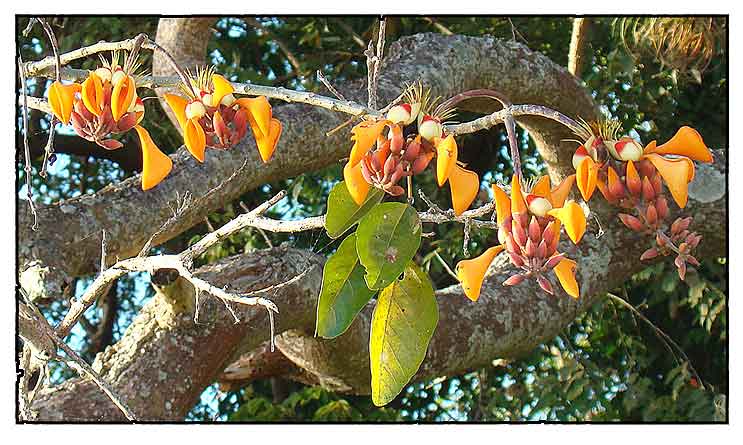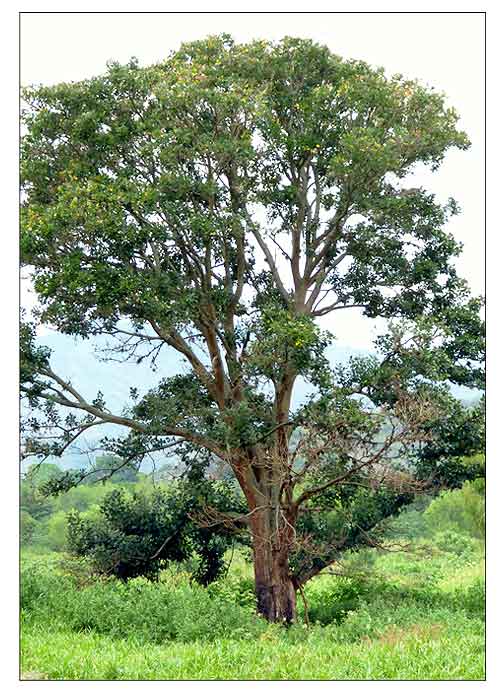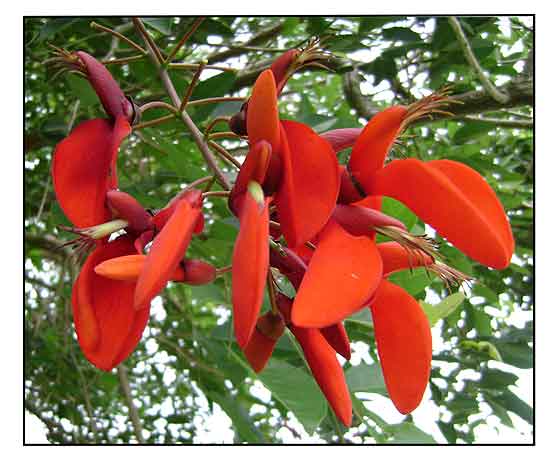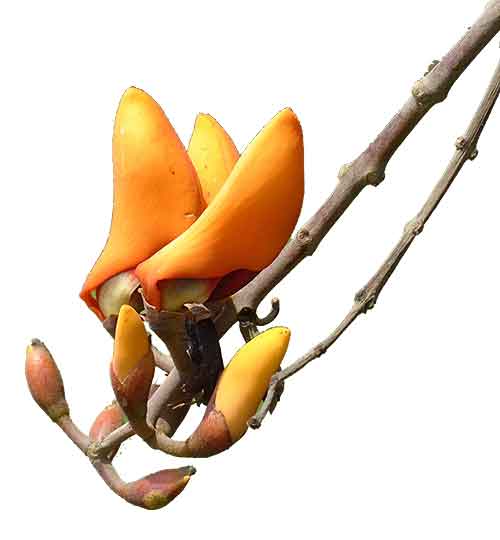 Gen info Gen info
- Erythrina is a genus of plants in the pea family, Fabaceae, containing about 130 species.
-
Erythrina fusca is a species of flowering tree in the legume family, Fabaceae.
- E. fusca has the widest distribution of any Erythrina species; the only one found in both New and Old World. (2)
- Erythrina fusca is the official flower of Trujillo, Venezuela. (2)
- Etymology: The genus name Erythrina derives from the Greek word eruthros, meaning "red", referring to the showy red flowers of Erythrina species. The species name fusca derives from Latin, meaning tawny or brownish-gray.
 Botany Botany
• Erythrina fusca is a medium to large spreading tree, reaching 10-15 (max. 26) m tall; crown rounded; trunk short, spiny (spines 1-2 cm long), much branched, sometimes buttressed to 2 m; bark brownish-gray or olive-brown, flaky; branches spreading, spiny; branchelets stout, spineless or aculeate. Leaves alternate, trifoliate; stipules and stipels orbicular, caducous; petiole up to 25 cm long, sometimes sparsely prickly; rachis up to 5 cm long, petiolule up to 1.5 cm; leaflets ovate to elliptical. Inflorescence racemose, terminal, appearing when leaves are present, with pale brick-red or salmon flowers in fascicles scattered along the rachis, covered with deciduous, ferruginous hairs, mostly unarmed peduncle up to 13 cm long; rachis 8-30 cm long; pedicel up to 2 cm long; stamens 10, 4-6 cm long, 1 free, 9 united in lower half into staminal tube; pistil 4-6 cm long; ovary densely pubescent. Fruit a woody, linear compressed pod, dehiscent, slightly constricted between 3-15 seeds; stipe stout, 1.5 cm long; beak 2 cm long, velvety, ferruginously hairy when young, later glabrescent; seeds oblong-ellipsoid, 12-18 x 5-8 mm, dark brown or black. (3)
Distribution
- Native to the Philippines. (1)
- Also native to Andaman Is., Assam, Bangladesh, Belize, Bismarck Archipelago, Bolivia, Borneo, Brazil North, Brazil Northeast, Brazil Southeast, Brazil West-Central, Cambodia, Caroline Is., Central American Pac, Colombia, Comoros, Costa Rica, Cuba, Dominican Republic, Ecuador, El Salvador, Fiji, French Guiana, Guatemala, Guyana, Honduras, India, Jawa, Laos, Leeward Is., Madagascar, Malaya, Maluku, Myanmar, New Caledonia, New Guinea, Nicaragua, Panamá, Peru, Puerto Rico, Queensland, Samoa, Solomon Is., Sri Lanka, Sulawesi, Sumatera, Suriname, Tanzania, Thailand, Tonga, Trinidad-Tobago, Vanuatu, Venezuela, Vietnam, Windward Is. (1)
 Constituents Constituents
- Nutrient analysis of edible portion of leaves per 100 g dry matter yield: 20-22 g crude protein; in vitro digestibility range from 30-55%; mineral content: N 3.2 g, phophorus 0.15 g, potassium 1.0 g, calcium 1.3 g, magnesium 0.5 g. Alkaloids are erysotrine, erythraline, erysodine, serysovine, and erysopine.
(4)
- Study of ethyl acetate extract of stem bark yielded six flavonoids, lupinifolin (1), citflavanone (2), erythrisenegalone (3), lonchocarpol A (4), liquiritigenin (5), and 8-prenyldaidzein (6). (see study below)(5)
- Preliminary phytochemical screening of branches, leaves, and bark yielded alkaloids, flavonoids, triterpenoids, steroids, saponins, lactones, coumarins, reducing sugars, carotenoids, amines, and cardiac glycosides. (see study below) (9)
- Study of stems of E. fusca isolated three new pterocarpans, fuscacarpans A-C (1-3), along with 14 known compounds, sandwicensin (4), erythribyssin A (5), erythrabissin I (6), demethylmedicarpin (7), eryvarin D (8), erypoegin I (9), hydroxycristacarpone (10), orientanol A (11), scandenone (12), genistein (13), liquiritigenin (14), isoliquiritigenin (15), vestitone (16) and 3,7,4′-trihydroxyflavone (17).
(The isolates were evaluated for antibacterial, antiplasmodial, and cytotoxic activities.) (11)
- Chromatographic separation and purification of bark of E. fusca isolated eight compounds, five or which were identified: phaseolin (1), ß-amyrin (2), lupeol (3), stigmasterol (4), phytol (5). (see study below) (13)
- Study of stem bark isolated a new pterocarpan, 3-hydroxy-10-(3-hydroxy-3-methylbutyl)-9-methoxypterocarpan (1), along with seven known compounds, sandwicensin (2), erythrisenegalone (3), citflavanone (4), liquiritigenin (5), lonchocarpol A (6), lupinifolin (7) and 8-prenyldaidzein (8). (see study below) (15)
Toxicity concerns
- Like many Erythrina species, E. fusca contains toxic alkaloids, while utilized for its medicinal value, it is toxic or poisonous in larger amounts. Erythraline is its most common alkaloid.
Properties
- Studies have suggested antimalarial, antioxidant, antimicrobial, thrombolytic, cytotoxic, antiherpetic, analgesic, antidiarrheal properties.
Parts used
Leaves, bark, roots.
 Uses Uses
Edibility
- The buds and leaves are eaten as vegetable.
- In Guatemala, flowers are eaten. (3)
Folkloric
- In Indonesia, poultice of bark applied on fresh wounds. Decoction of bark and roots drunk against beriberi. (3)
Others
- Fodder: In Central America, used as fodder. (In Mandar, E. fusca leaves yielded 29.04% crude protein. 20)
- Fuel: Branches used as fuelwood, because of availability rather than preference.
- Repellent: Nectar used as ant-repellent.
- Agroforestry: Used in reforestation projects as nurse tree for other tree species. For intercropping, E. fusca tolerates prolonged drought without losing its leaves, recirculating nitrogen, phosphorus, and potassium from prunings. (3)
- Ornamental: Planted for ornamental purposes.
- Papermaking: Study showed potential for use as raw material for writing and printing grade pulp. (see study below) (17)
Studies
• Antimalarial / Flavonoids / Stem Bark: Study of ethyl acetate extract of stem bark yielded six flavonoids, lupinifolin (1), citflavanone (2), erythrisenegalone (3), lonchocarpol A (4), liquiritigenin (5), and 8-prenyldaidzein (6). Diprenylated flavanone 4 showed notable antimalarial activity against multi-drug resistant strain (K1) of Plasmodium falciparum, with IC50 of 1.6 µg/mL. (5)
• Anti-Epileptic / Bark: Study evaluated the in-vivo anti-epileptic effect of hydroalcoholic extract of E. fusca bark. Epileptic seizure challenged animals treated with extract doses of 250 and 500 mg/kg showed reduction in MES-induced tonic phase latency and also inhibited clonic seizure, Seizure duration was also lower in extract treated animals. (6)
• Antioxidant / Antimicrobial / Cytotoxic / Thrombolytic / Leaves and Stem Bark: A chloroform soluble methanol fraction of methanol extract of leaves showed highest free radical scavenging by DPPH assay with IC50 of 5.5 µg/mL, compared to standard ascorbic acid with IC50 of 5.8 µg/mL. Extracts also exhibited moderate antimicrobial activity against gram-positive, gram-negative, and fungal test pathogens. The chloroform soluble fractions of stem bark showed highest inhibitory effect with zone of inhibition of 19.3 mm against Bacillus cereus. All test samples showed cytotoxic activity using brine shrimp lethality assay, with chloroform fraction showing highest lethality with LC50 1.55 µg/mL. The carbon tetrachloride soluble fraction of stem bark showed highest clot lysis (22.75%) compared to standard streptokinase at 66.77%. (7)
• Antioxidant in Epileptic Models / Bark: Study evaluated the antioxidant activity of hydroalcoholic extract of bark of E. fusca in invivo experimental models. The hydroalcoholic extract of bark showed antioxidant effect against the animal models of epilepsy. The malondialdehyde levels were significantly increase in serum and brain tissue, while levels of SOD was significantly decreased in brain tissue, and epileptic seizures caused a significant (p<0.01) depletion in reduced glutathione (GSH) level in rat brain tissue with intoxication of epileptic seizures by MES, PTX, and PTZ models of epilepsy. The decrease in MDA and increase in SOD and GSH in extract treated epileptic models may be due to its antioxidant property. (8)
• Antiherpetic: Study evaluated polar extracts for activity against herpes simplex virus types 1 and 2. The extracts inhibited growth of HS type 1 at effective medium concentration of 243 µg/mL and HS type 2 at 109.5 µg/mL. (see constituents above) (9)
• Acute and Sub-Chronic Toxicity Studies / Fruit: Study evaluated the safety of ethanol fruit extract of E. fusca in Swiss albino mice. Testing used single doses of 1000, 3000, and 5000 mg/kg and repeated doses of 100, 300, and 500 mg/kg for 90 days, measuring body weight, food and water consumption, blood and biochemical parameters, organ weight, and histopathology. Results showed no evidence of morphological and histopathological damage. Results affirm the safety of the ethanol fruit extract. (10)
• Cytotoxicity Testing against Cancer Cell Line HepG2 / Leaf, Twig, Flower: Study evaluated the cytotoxic activities of methanolic extracts of leaves, twigs, and flowers of E. fusca against human cancer cell lines (HepG2) and monkey kidney normal cell line (Vero). Extracts showed no toxicity on both cell lines with IC50s of more than 100 µg/mL and therapeutic index of less than 2. (12)
• Antimalarial / Plasmodium falciparum / / Analgesic / Antidiarrheal: Chromatographic separation and purification of bark of E. fusca isolated eight compounds, five or which were identified: phaseolin (1), ß-amyrin (2), lupeol (3), stigmasterol (4), phytol (5). The five compounds showed significant antimalarial activity against 3D7 and Dd2 strains (IC50s 4.94-22 µg/mL). Potent central analgesic, antioxidant, and anti-diarrheal activities (p<0.05) and mild thrombolytic and membrane stabilization properties were also observed. Molecular docking of Phaseolin bolsters its potential as a new antimalarial drug candidate.(13)
• Antiproliferative / HeLa Cells / Leaves: Study evaluated a chloroform extract of E. fusca leaves and its isolates on HeLa cervical cancer cells. The extract and isolate #30 showed cytotoxic activity with IC50 of 16 and 5 µg/mL, respectively. The effluent #30 did not affect HeLa cells growth at the given concentration, but it might promote DNA fragmentation indicating apoptosis induction. (14)
• Pterocarpan / Antibacterial / Stem Bark: Study of stem bark isolated a new pterocarpan, 3-hydroxy-10-(3-hydroxy-3-methylbutyl)-9-methoxypterocarpan (1), along with seven known compounds, sandwicensin (2), erythrisenegalone (3), citflavanone (4), liquiritigenin (5), lonchocarpol A (6), lupinifolin (7) and 8-prenyldaidzein (8). Lonchocarpol, compound 7, exhibited strong antibacterial activities against Staphylococcus aureus, Bacillus subtilis, and Enterococcus faecalis. Compounds 2, 3, 6, and 7 exhibited weak antimycobacterial activity with MICs of 100, 50, 50, and 25 µg/mL, respectively. (15)
• Bactericidal in Periodontal Disease / Leaves: Study evaluated the bactericidal effect of E. fusca leaves Aquadest Extract EFLAE) at various concentrations on P. gingivalis and cytotoxic effect on fibroblast. Chlorhexidine was used as positive control. The EFLAE showed concentration dependent bactericidal effect on P. gingivalis starting from 78%. The 90% EFLAE concentration had stronger bactericidal effect (35.004) than chlorhexidine (32.313). With 100% EFLAE, no cytotoxic effect was detected on NIH 3T3 cells. (16)
• Potential as Pulping Raw Material: Study evaluates the efficacy of E. fusca as pulping raw material in measures of anatomical, morphological, and chemical properties. It is characterized with 47.0%
α-cellulose and 28.8% lignin content with fiber length of 1.11 mm. Optimum conditions were 14% active alkali for 2 h cooking at 170°C, with pulp yield of 40% with kappa number of 26.6. Tensile index was 52.4 N mg-1 with tear index of 6.8 mN m2g-1 at SR of 57. Results suggest the species can be used as raw material for writing and printing grade pulp. (17)
• Estrogenic Activity: Study screened methanol extracts of 40 plants from Egyptian and Thailand folk medicine for estrogen agonist and antagonist activities using yeast two-hybrid assay system expressing ERα and ERß. The methanol extract of Erythrina fusca showed estrogenic activity on ERß only, with concentration-dependent increase in activity. (18)
• Silver Nanoparticles / Antibacterial against Periodontal Disease / Leaves: Study reports on the green synthesis of AgNPs using E. fusca leaves aqueous extract. The AgNPs were evaluated against periodontal disease-causing pathogenic microflora using well diffusion method. Results showed maximum inhibitory zones of 13 and 18 mm against Bacillus cereus, 11 and 19 mm for Pseudomonas aeruginosa, 10 and 18 mm for E. coli, 9 and 15 mm for S. pyogenes in 50 and 100 µg/ml doses. (19)
Availability
- Wild-crafted.
|

![]()



 Gen info
Gen info
 Constituents
Constituents
